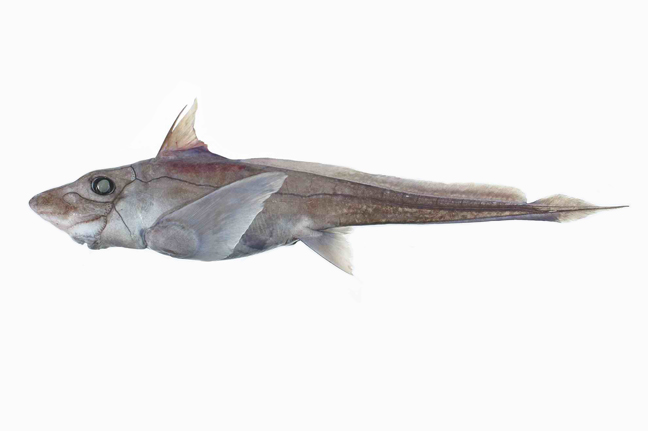Abyssal Whitefin, Hydrolagus trolli Didier & Séret 2002
Other Names: Abyssal Ghostshark, Pointynose Blue Ghost Shark , Pointy-nosed Blue Chimaera, Pointy-nosed Blue Ratfish, Ray Troll’s Chimaera

Abyssal whitefin, Hydrolagus trolli - from 1350 metres on the Lord Howe Rise in the Tasman Sea. Source: Robin McPhee & Mark McGrouther / NORFANZ Founding Parties. License: All rights reserved
Summary:
A bluish-grey ghostshark with bluish fins, small eyes surrounded by a black ring, a prominent blackish lateral line, and a concave first dorsal fin with a pale margin. Males have long claspers with bulbous bristle-covered ends.
As the name suggests, the Abyssal Whitefin is one of the deepest ranging ghostsharks, and almost nothing is known of its biology.
Video of Hydrolagus cf trolli off Hawaii.
As the name suggests, the Abyssal Whitefin is one of the deepest ranging ghostsharks, and almost nothing is known of its biology.
Video of Hydrolagus cf trolli off Hawaii.
Cite this page as:
Reardon, M.B. & Bray, D.J. 2018, Hydrolagus trolli in Fishes of Australia, accessed 01 Jul 2025, https://fishesofaustralia.net.au/home/species/2672
Abyssal Whitefin, Hydrolagus trolli Didier & Séret 2002
More Info
|
Distribution |
Off Cape Everard, Victoria, and on the Lord Howe Rise and the Norfolk Ridge in the Tasman Sea (AUS EEZ). The species occurs elsewhere in the south-west and central Pacific (off New Caledonia and New Zealand), and possibly off the west coast of Hawaii and off California, USA. Depth range: 1670-2000 off continental Australia and 600-1700 m elsewhere. |
|
Features |
Snout pointed; preopercular and oral lateral-line canals sharing a common branch; first dorsal fin concave with pale margin. Males with a deeply curved frontal tenaculum that is upturned distally with spines along dorsal upturned edge; prepelvic tenacula deeply indented along distal margin. Pelvic claspers with pale fleshy distal lobes, divided distally for 1/3 their length, tips usually extending beyond distal edge of pelvic fins. Ventral caudal fin not deeply indented at its origin to form a separate anal fin. |
|
Colour |
Bluish-grey with a dark line around the orbit and dark shadowing along lateral-line canal edges. |
|
Etymology |
Hydrolagus is from the Greek hydr meaning water, and lagos meaning hare. The species is named trolli after the wonderful Alaskan artist Ray Troll, an ''artist of fishes and one of the few true chimaeroid lovers of the world". |
|
Species Citation |
Hydrolagus trolli Didier & Séret 2002, Cybium 26(3): 227. Type locality: off New Caledonia [24°44.90'S, 167°43'.10'E], ♂. |
|
Author |
Reardon, M.B. & Bray, D.J. 2018 |
|
Resources |
Abyssal Whitefin, Hydrolagus trolli Didier & Séret 2002
References
Compagno, L.J.V. & Dagit, D.D. 2015. Hydrolagus trolli. The IUCN Red List of Threatened Species 2015: e.T60197A70709551. http://dx.doi.org/10.2305/IUCN.UK.2015-4.RLTS.T60197A70709551.en. Downloaded on 27 October 2016.
Didier, D.A. & Séret, B. 2002. Chimaeroid fishes of New Caledonia with description of a new species of Hydrolagus (Chondrichthyes, Holocephali). Cybium 26(3): 225-233. See ref online, open access
Kemper, J.M., Ebert, D.A. & Didier, D.D. 2015. 5 Family Chimaeridae, pp 40-49 in Roberts, C.D., Stewart, A.L. & Struthers, C.D. (eds) The Fishes of New Zealand. Wellington : Te Papa Press Vol. 2 pp. 1-576.
Last, P.R. & Stevens, J.D. 2009. Sharks and Rays of Australia. Collingwood : CSIRO Publishing Australia 2, 550 pp.
McMillan, P.J., M.P. Francis, G.D. James, L.J. Paul, P.J Marriott, E. Mackay, B.A. Wood, L.H. Griggs, H. Sui & F. Wei, 2011. New Zealand fishes. Volume 1: A field guide to common species caught by bottom and midwater fishing. New Zealand Aquatic Environment and Biodiversity Report No. 68. 329 pp. PDF
Paulin, C., Stewart, A., Roberts, C. & McMillan, P. 1989. New Zealand fish: a complete guide. National Museum of New Zealand Miscellaneous Series 19: 1-279. (as Hydrolagus sp. C)
Reichert, A.N., Lundsten, L., & Ebert, D.A. 2016. First North Pacific records of the pointy nosed blue chimaera, Hydrolagus cf. trolli (Chondrichthyes: Chimaeriformes: Chimaeridae). Marine Biodiversity Records 1–5. Open access http://doi.org/10.1186/s41200-016-0095-5




